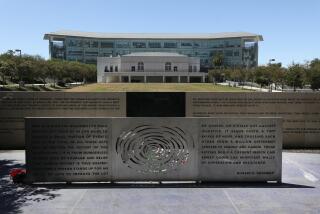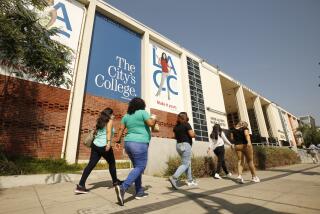L.A. College District Uses Most of Reserves
- Share via
The Los Angeles Community College District has severely depleted its financial reserves after a five-year budget slide, triggering a state review to assess what can be done to strengthen the district’s meager coffers.
A midyear budget report released to the board of trustees Wednesday estimated that the Los Angeles district, the nation’s largest, will end the year with $5.6 million, less than 2% of its $282-million budget. Only two of the 71 community college districts in California--Compton and Victor Valley in San Bernardino County--have such low balances.
“This is definitely a concern. No question about it,” Vishwas More, president of the California Community College system’s Board of Governors, said Thursday. “Definitely anything of this nature is an alarm indicator that something needs to be done.”
Los Angeles district officials stressed that their estimates are deliberately conservative. But the data nonetheless depicts a financially troubled system that has failed to stop a persistent budget problem, in part brought on by declining student enrollment.
Officials also predicted that the district may, for the first time, violate a state law that requires at least half of all expenditures for classroom instruction. If this projection holds true, Los Angeles officials will either have to seek a state waiver to the rule or make up the monetary difference in future years.
Last year, only one district in California--Mt. San Jacinto Community College District in Riverside County--failed to meet that standard.
The data mirrors a similar decline a decade ago in the Los Angeles district. At that time, the district became insolvent, required a $5-million county bailout, and drew a county grand jury probe that found fiscal mismanagement.
Neil Yoneji, current chancellor of the nine-campus, 97,212-student district, conceded “there is no good thing about where we are,” but insisted the district is not headed toward a repeat of the past crisis.
“I think it would be highly premature to make that suggestion,” Yoneji said.
The report blamed the poor financial picture on plummeting enrollments that have reduced state funding, an unexpected drop in tuition collected from foreign students, a costly faculty early retirement plan, and a $1-million payment on the district’s new downtown headquarters.
Officials with the California Community College chancellor’s office, who will review the local budget, expressed concern Thursday over the downward slide.
“When we look at it, I would say, ‘Yes, it’s a problem. It is serious,’ ” state Chancellor David Mertes said. But just how Los Angeles officials plan to remedy the problem remained unclear Thursday. Yoneji said the district’s fiscal problems this year should not have any direct impact on its students. He predicted that some kind of spending cuts would be needed, but declined to identify vulnerable areas.
Also, district officials said they hope to achieve a fiscal turnaround by increasing enrollment, which brings additional state funding, and dovetail on an overall improving state economy.
Enrollment fell 17% from 1991 to 1995, a greater decline than in any surrounding community college district. Over that same period, the district’s ending balance also steadily dropped, from $14.7 million in 1991 to $9.8 million as of last June.
Under state guidelines, community college districts are expected to maintain at least a 5% ending balance in their general funds. The Los Angeles district already was on a state watch list because its prior balance had fallen between 3% and 5%.
Although there is no state penalty for falling below the guidelines, an advisor probably will be dispatched to Los Angeles to review local books.
More to Read
Sign up for Essential California
The most important California stories and recommendations in your inbox every morning.
You may occasionally receive promotional content from the Los Angeles Times.










